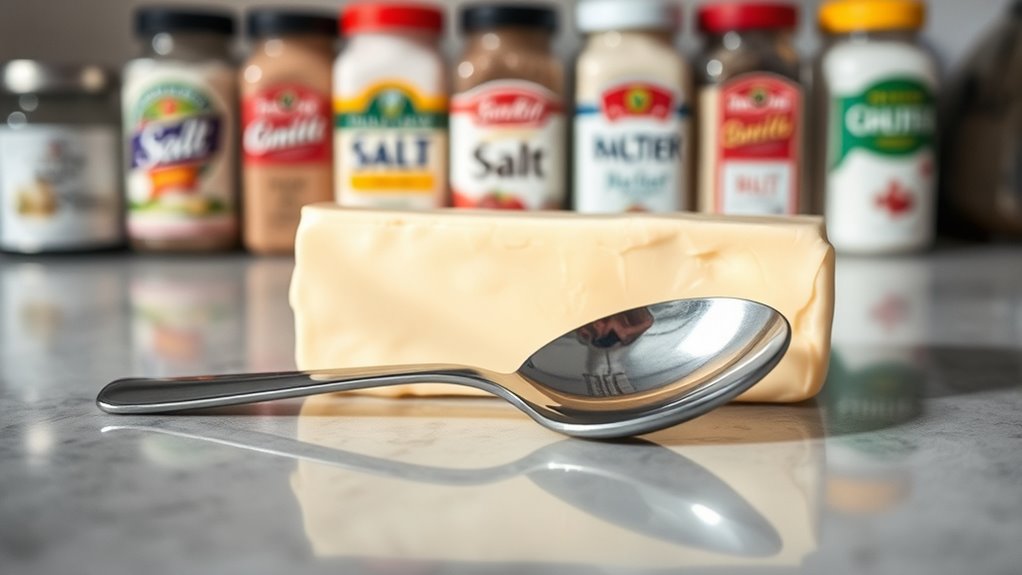When choosing butter, be mindful of its sodium and salt content. A tablespoon of salted butter packs about 90 mg of sodium, while unsalted options offer a lower sodium alternative for better recipe control. Always check labels, as sodium levels can vary among brands, especially with added flavorings or preservatives. Managing your sodium intake is key to a balanced diet, and knowing how to select butter wisely can help you enjoy your meals more. There’s even more to discover about butter choices!
Key Takeaways
- Sodium levels in butter are crucial for dietary health; a tablespoon of salted butter contains about 90 mg of sodium.
- Salted butter has added sodium for flavor, while unsalted butter offers a lower sodium option for better salt control.
- Labels typically list sodium in milligrams per serving, aiding consumers in managing their overall sodium intake.
- Variability in sodium content exists due to different brands and additional ingredients, so always compare labels carefully.
- Being mindful of sodium helps maintain health while enjoying butter, and consulting professionals can provide personalized guidance.

When you spread butter on your toast, you might not think about its sodium and salt content, but these elements play a significant role in your diet. Understanding the sodium levels in butter is essential, especially if you’re watching your intake for health reasons. While butter is often celebrated for its rich flavor and creamy texture, it’s important to recognize that it can also be a source of sodium, which you may not immediately associate with a natural product like this.
When you look at a butter label, you’ll typically see the sodium content listed in milligrams. This is vital information, especially if you’re trying to adhere to a specific dietary plan. The American Heart Association recommends limiting sodium intake to less than 2,300 mg per day, and ideally, aiming for around 1,500 mg. A single tablespoon of salted butter can contain around 90 mg of sodium. That might not sound like much, but if you’re using butter frequently, those numbers can add up quickly and impact your overall sodium levels.
Salt content in butter varies depending on whether you choose salted or unsalted options. Salted butter contains added salt, which enhances flavor but also increases sodium levels. Unsalted butter, on the other hand, provides a purer taste and allows you to control the amount of salt in your dishes. If you’re aiming to reduce your sodium intake, opting for unsalted butter can be a wise choice, giving you the flexibility to add salt as needed in your recipes.
It’s important to read labels carefully because not all butters are created equal. Some brands might have additional flavorings and preservatives, which can also affect sodium levels. When shopping, compare different products to find one that aligns with your dietary preferences and needs. If you’re unsure about how much sodium is acceptable for you, consulting a healthcare professional can provide personalized guidance. Incorporating butter into your diet doesn’t have to be a guilty pleasure; understanding your macronutrient ratios can help you balance your meals effectively.
By being mindful of its sodium and salt content, you can enjoy it while still keeping your overall health in check. So, the next time you reach for that butter dish, take a moment to glance at the label. It’ll help you make informed choices that align with your dietary goals, allowing you to savor that delicious toast without the worry.
Frequently Asked Questions
Can I Use Butter on a Low-Sodium Diet?
You can use butter on a low-sodium diet, but it’s wise to monitor your intake. Consider butter substitutes like olive oil or avocado, which provide flavor enhancement without the high sodium levels. These alternatives can keep your meals tasty while sticking to your dietary goals. Just be mindful of portions, as even lower-sodium options can add up. Experiment with herbs and spices to boost flavor without relying solely on butter.
What Are the Health Effects of High Sodium Intake?
High sodium intake can hit your body like a storm, causing serious health issues. It raises your blood pressure, increasing hypertension risks that strain your heart. Over time, this can lead to heart disease. Additionally, excessive sodium can harm your kidney health, making it harder for them to filter waste. By reducing your sodium intake, you can protect your overall well-being and keep your body functioning smoothly.
Is Salted Butter Healthier Than Unsalted Butter?
Salted butter isn’t necessarily healthier than unsalted butter. It contains added salt, which can enhance flavor but increases sodium intake. If you’re watching your salt content for health reasons, unsalted butter is the better choice. However, if you enjoy the taste of salted butter in your dishes, just be mindful of your overall sodium consumption. Balancing flavor with health is key, so choose based on your dietary needs and preferences.
How Does Butter Compare to Margarine in Sodium Content?
You might be surprised to learn that when you delve into a sodium levels analysis, butter often has lower sodium content compared to margarine. While salted butter can have around 90 mg of sodium per tablespoon, many margarines can contain between 100 to 200 mg. So, if you’re watching your salt intake, a salt content comparison reveals that butter might be your better choice. Keep this in mind when selecting spreads for your meals!
Are There Sodium-Free Butter Alternatives Available?
Yes, there are sodium-free butter alternatives available! You can find various butter substitutes made from plant-based oils, nuts, or even coconut that don’t contain added sodium. Look for brands specifically labeled as “sodium-free” to guarantee you’re getting a product without salt. These sodium-free options can be perfect for cooking or spreading on bread, giving you the creamy texture you crave without the added sodium. Enjoy experimenting with different flavors!
Conclusion
When you’re scanning butter labels, remember that a tablespoon typically contains about 90 milligrams of sodium. While that might not seem like much, it can add up quickly if you’re watching your salt intake. So, whether you’re using it in cooking or spreading it on toast, being mindful of your butter choice can help you keep your sodium levels in check. Don’t forget to enjoy it in moderation for a delicious balance!









